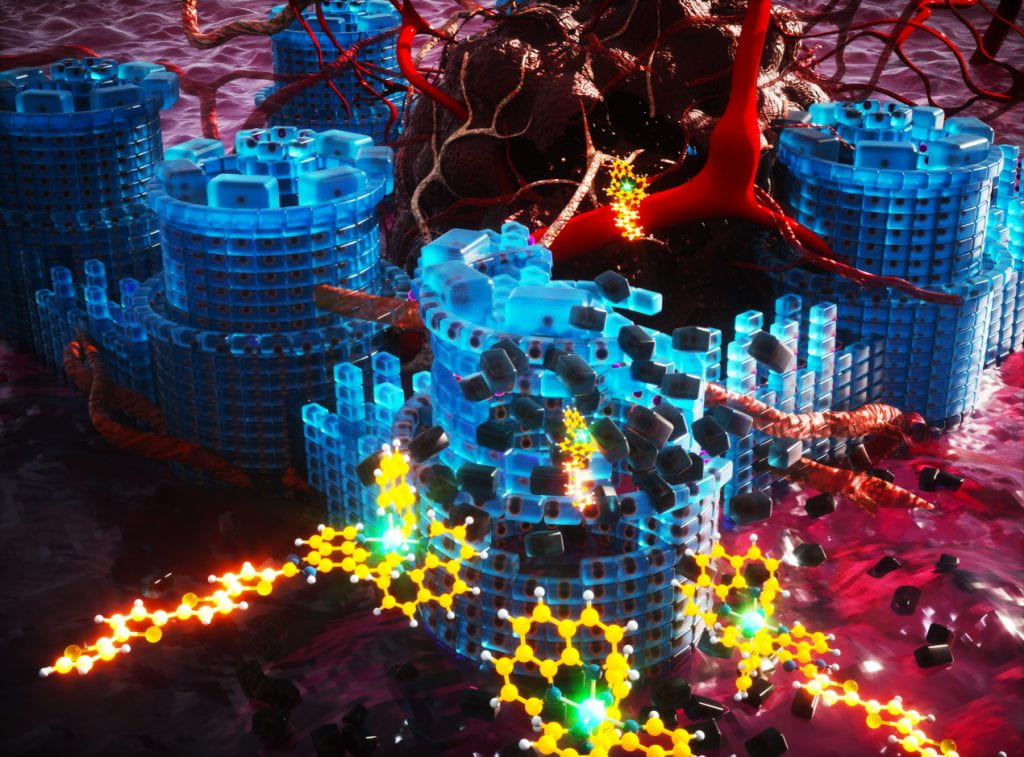
Treating cancer with light: our approach
Cancer continues to be a leading health concern, with nearly 10 million deaths attributed to the disease worldwide in 2020. New treatment modalities are under constant development to augment the existing options, i.e., surgery, chemotherapy, radiation, etc., or to replace them altogether in patients for which the conventional options have failed. Ideally, treatment would deliver cytotoxic activity only to the affected tissue, thereby avoiding the debilitating systemic effects often associated with cancer treatment.
One approach is to introduce an otherwise non-toxic prodrug that can be activated to destroy tumors and tumor vasculature. In our group we develop such compounds, using light energy to switch on the drug: confining the light treatment to only the affected area allows for spatial and temporal targeting of diseased tissue while minimizing damage to healthy tissue. The energy of the incident light promotes the compound — the photosensitizer — to an electronically excited state that can undergo subsequent chemical processes involving energy and/or electron transfer reactions. If oxygen is present, these reactions can generate cytotoxic reactive oxygen species, such as singlet oxygen, which is the defining characteristic of photodynamic therapy (PDT).
The key, then, is to create compounds that can perform well as photosensitizers. Our approach largely focuses on polypyridyl complexes of ruthenium and osmium. These compounds offer several features that can be tuned for optimal photosensitizer design. First, they are inherently modular, in that the design of the individual constituent ligands can manipulate important physical and chemical properties of the assembled complex. Second, metal complexes generally offer a variety of electronic excited state configurations that can be accessed through specific ligand combinations. These different types of excited states have their own characteristic reactivity, so the photophysical pathways can be controlled by ligand selection. Third, pi expansive ligands can serve as excellent reservoirs for long-lived excited states such as the triplet intraligand state, and the reaction energetics of these long-lived states are regulated by molecular architecture.
Therefore, by carefully designing the constituent ligands, we can tune the photophysical properties that in turn drive the photocytotoxic potency of the compounds as photosensitizers. We characterize the photophysics of our compounds using a suite of time-resolved and steady-state spectroscopic methods. We also test potency of our photodrugs using in vitro and in vivo cancer models under varying physiological conditions, e.g., depleted oxygen concentration. The photophysical and photocytotoxicity data informs the synthetic design of next-generation photosensitizers. This strategy has produced TLD1433, the first ruthenium-based photodrug to enter human clinical trials, and it is currently in a Phase II trial for bladder cancer. We have since produced many next-generation lead compounds, optimizing for specific cancer types using a tumor-based design philosophy.
Latest news
- Kim takes a prize
Kim Luu won 3rd place at this year’s All Majors Poster Symposium 🎉

- MavPitch Double Win
Alisher and Broderick each won cash prizes at the 2025 MavPitch Business Competition, and they are featured in this article.

- Colin formerly inducted as NAI Senior Member
Colin was formerly inducted into the National Academy of Inventors as a Senior Member at the 2025 conference in Atlanta

- Multiple wins at ACS MiM!
Alisher and Gurleen each took 1st in their respective graduate divisions, and Debby won 2nd in her undergraduate section at the Americal Chemical Society Meeting in Miniature at East Texas A&M this weekend!

- Alisher’s poster takes 2nd place
Alisher won 2nd place at the CGSA research poster symposium!
